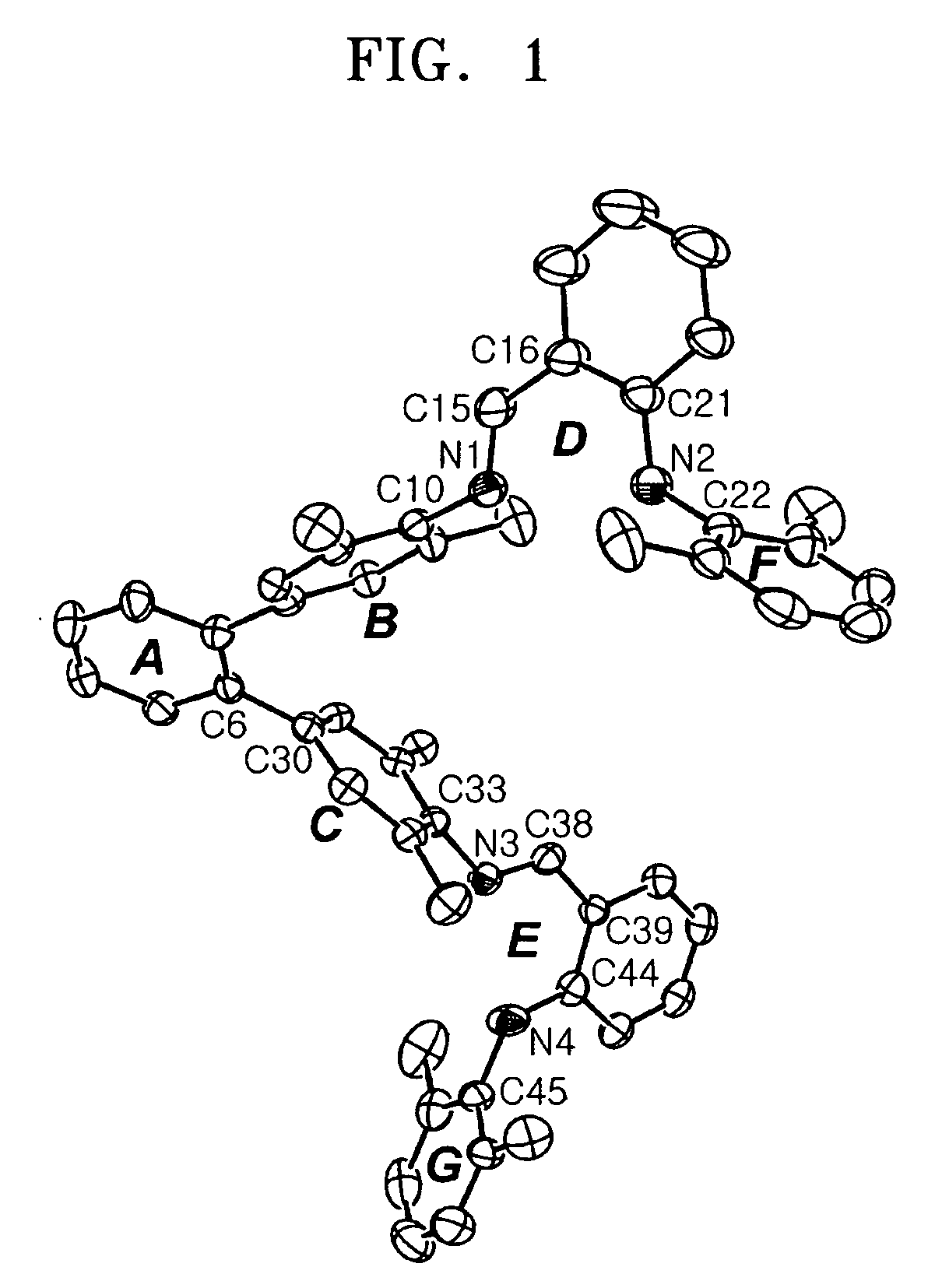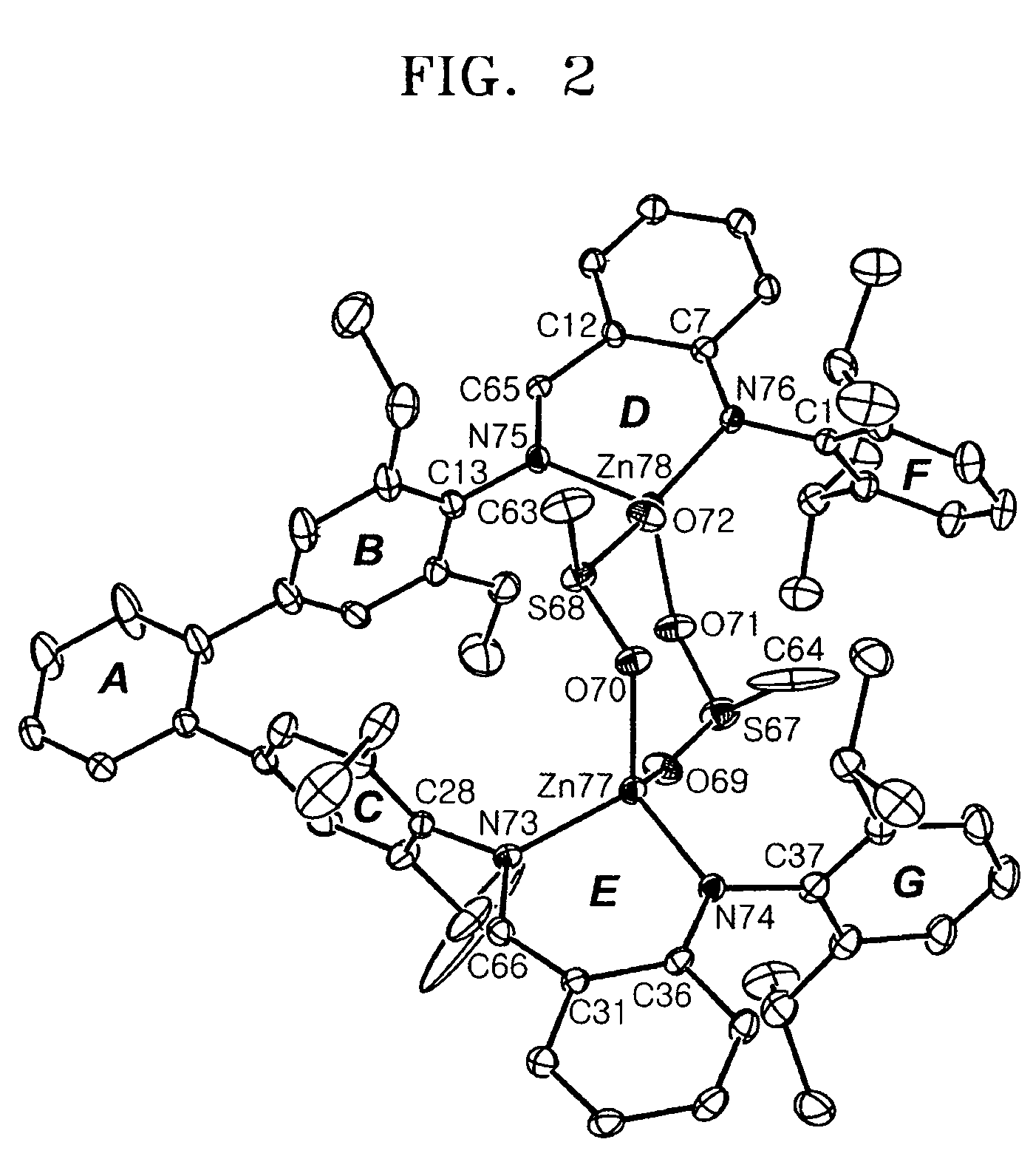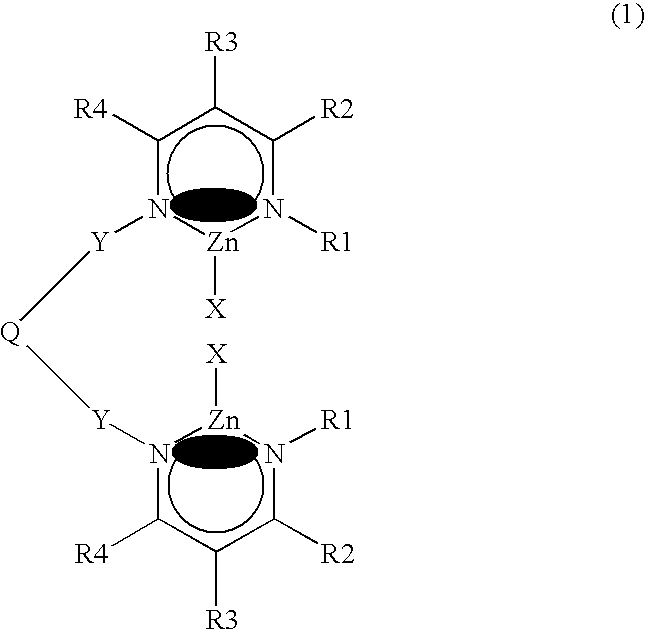Bimetallic zinc complex and process of producing polycarbonate using the same as polymerization catalyst
a polymerization catalyst and bimetallic zinc technology, applied in biochemistry, organic chemistry, make-up, etc., can solve the problems of low activity of catalysts, catalysts cannot be used, and catalysts have a very low activity, so as to reduce the amount of catalysts
- Summary
- Abstract
- Description
- Claims
- Application Information
AI Technical Summary
Benefits of technology
Problems solved by technology
Method used
Image
Examples
example 1
Synthesis of N-diphenylmethylene-2,6-diisopropyl-4-bromoaniline (compound (1))
[0104]40.7 g (0.195 mol) of tetraethoxysilane and 0.5 mL of sulfuric acid were added to a flask equipped with a distiller, containing 43.9 g (0.169 mol) of 4-bromo-2,6-diisopropylaniline and 24.8 g (0.130 mol) of benzophenone under a nitrogen atmosphere. The mixture was reacted by heating at 160° C. for 2 days while removing formed ethanol using the distiller. After the reaction, the resultant product was cooled to room temperature. Then, 200 mL of 1.0 M aqueous solution of potassium hydroxide was added to the resultant product and stirred for 10 minutes to obtain yellow precipitates. The obtained precipitates were filtered off and dissolved in 300 mL of ethyl acetate, and then dried over anhydrous magnesium sulfate. The solvent was removed by distillation under reduced pressure to obtain a yellow solid. Then, the yellow solid was recrystallized in hexane at −20° C. to obtain 42 g of N-diphenylmethylene-2,...
example 2
Synthesis of N-diphenylmethylene-2,6-diethyl-4-bromoaniline (compound (2))
[0106]N-diphenylmethylene-2,6-diethyl-4-bromoaniline was synthesized using the same manner as in Example 1, except that 4-bromo-2,6-diethylaniline was used in place of 4-bromo-2,6-diisopropylaniline.
[0107]Yield 75%. M.p. 112° C. IR (KBr): 1612 (C═N) cm−1. 1H NMR (CDCl3): δ 7.74 (d, J=8.0 Hz, 2H, o-H), 7.44 (t, J=7.2 Hz, 1H, p-H), 7.37 (t, J=7.2 Hz, 2H, m-H), 7.21 (t, J=7.6 Hz, 1H, p-H), 7.17 (t, J=7.6 Hz, 2H, m-H), 7.04 (d, J=8.0 Hz, 2H, o-H), 7.03 (s, 2H), 2.47 (dq, J=15.2, 7.6 Hz, 2H, CH2), 2.21 (dq, J=15.2, 7.6 Hz, 2H, CH2), 1.09 (t, J=7.2 Hz, 6H, CH3) ppm. 13C{1H} NMR(CDCl3): δ 167.08, 147.09, 139.63, 136.35, 133.73, 130.85, 129.57, 129.40, 128.67, 128.37, 128.06, 125.54, 116.09, 24.96 (CH2), 13.69 (CH3) ppm. Anal. Calc. (C23H22BrN): C, 70.41; H, 5.65; N, 3.57%. Found: C, 70.34; H, 5.44; N, 3.49%.
example 3
Synthesis of N-diphenylmethylene-2,6-dimethyl-4-bromoaniline (compound (3))
[0108]N-diphenylmethylene-2,6-dimethyl-4-bromoaniline (compound (3)) was synthesized using the same manner as in Example 1, except that 4-bromo-2,6-dimethylaniline was used in place of 4-bromo-2,6-diisopropylaniline.
[0109]Yield 59%. M.p. 88° C. IR (KBr): 1616 (C═N) cm−1. 1H NMR (CDCl3): δ 7.74 (d, J=7.2 Hz, 2H, o-H), 7.42 (t, J=7.2 Hz, 1H, p-H), 7.35 (t, J=7.6 Hz, 2H, m-H), 7.23 (t, J=7.2 Hz, 1H, p-H), 7.17 (t, J=7.2 Hz, 2H, m-H), 7.05 (d, J=7.6 Hz, 2H, o-H), 6.98 (s, 2H), 1.99 (s, 6H, CH3) ppm. 13C{1H} NMR(CDCl3): δ 167.96, 148.20, 139.58, 136.74, 130.99, 130.48, 129.59, 129.52, 128.50, 128.43, 128.27, 128.15, 115.43, 18.85 (CH3) ppm. Anal. Calc. (C21H18BrN): C, 69.24; H, 4.98; N, 3.85%. Found: C, 69.03; H, 5.08; N, 3.74%.
[0110]Compounds (1) through (3) have the following formulae, respectively.
[0111]
Compound123RiPrEtMe
PUM
| Property | Measurement | Unit |
|---|---|---|
| molecular weight distribution | aaaaa | aaaaa |
| temperature | aaaaa | aaaaa |
| temperature | aaaaa | aaaaa |
Abstract
Description
Claims
Application Information
 Login to View More
Login to View More - R&D
- Intellectual Property
- Life Sciences
- Materials
- Tech Scout
- Unparalleled Data Quality
- Higher Quality Content
- 60% Fewer Hallucinations
Browse by: Latest US Patents, China's latest patents, Technical Efficacy Thesaurus, Application Domain, Technology Topic, Popular Technical Reports.
© 2025 PatSnap. All rights reserved.Legal|Privacy policy|Modern Slavery Act Transparency Statement|Sitemap|About US| Contact US: help@patsnap.com



